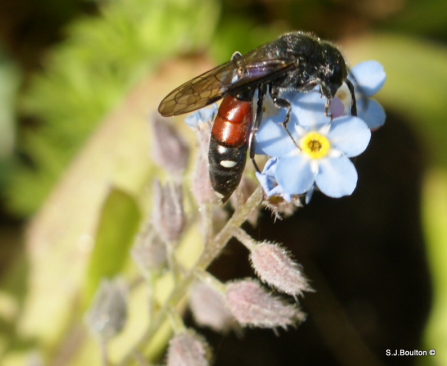One of those species is Bombus hypnorum - the tree bumblebee.
Late spring bees and wasps
Osmia caerulescens (blue mason bee) male and female by Ian Gillen
Bombus hypnorum (tree bumblebee) by Ken Gartside
A good news story as far as bees are concerned, B hypnorum has been steadily increasing it’s range since it was first recorded in Britain in 2001 near Southampton. Bombus hypnorum is a versatile nester with a preference for aerial cavities such as roof spaces and is commonly recorded as nesting in bird boxes but will also nest nearer to the ground in compost bins and small rodent burrows and completes two brood cycles a year and we will be seeing their first tiny workers around now.
Nesting Bombus hypnorum (tree bumble) colony by Dave Jones
Moving on to another aerial nesting bee and I’m sure one many readers will have experienced using gaps or holes in fencing or walls around their homes is Osmia bicornis - the red mason bee. Another very common bee and visitor to bee hotels. The males have a very handsome mustache of pale hairs on the face and the females darker with orange pollen collecting hairs on the underside of the abdomen and two horns on the face. O bicornis females create their nest cells using mud which they scrape into a ball and carry back to the nest site. During times of little rain it’s worth keeping a patch of the garden watered and you may be lucky enough to see them in action.
Osmia bicornis (red mason bee) male and female by Karen McCartney
Another Osmia species we see in Greater Manchester and Lancashire is the small bee Osmia caerulescens - the blue mason bee. A small dark bee with a black pollen brush under her abdomen and a bluish metallic sheen to her body. Males when fresh have golden hairs covering the body and metallic eyes. Another versatile nester that uses a variety of holes and cavities and will sometimes use bee hotels if smaller holes are provided and partitions it’s nests with chewed leaves and sometimes petals. A regular visitor to clover and hardy geranium in my garden.
Osmia caerulescens (blue mason bee) male and female by Ian Gillen
Wasps are a particular favourite of mine and Sapya quinquepunctata is a solitary wasp and cleptoparasite of a number of Osmia species. The female S quinquepunctata has a long body with red and white distinctive markings with males more slender and darker and lacking the red banding. I suspect it is under-recorded here in Greater Manchester and Lancs and does very well in my garden. The females enter the nest of the host and lays an egg nearby the host’s egg. The first instar larva eats the egg of the host and develops using the host’s provisions. As with most cuckoo species the presence of this wasp is indicative of a healthy population of the host species and males should be appearing here soon.

Sapyga quinquepunctata by Stephen Boulton
Many thanks to the members of UK Bees, Wasps and Ants and to The Bees, Wasps and Ants Recording Society (BWARS) for allowing me to use their images.
Action for Insects
Can you imagine a world without insects? Sadly, this isn't as far-fetched as it might sound - we're in the middle of a catastrophic decline in insect numbers.
Luckily, each and every one of us can do at least one thing to help insects thrive where we live.

